As you may have heard, Bozeman, Montana is within shouting distance of some of the West’s finest trout streams. You’re no doubt familiar with the Yellowstone, the Gallatin, the Madison and the Missouri. Not only are they incredible fisheries, but they’re also part of America’s angling lore. Fly fishers from all over the U.S. — indeed, from all over the world — travel to Bozeman with the hope of tempting wild trout on Montana’s storied waters.
When I lived in Bozeman, though, the nearby rivers were rarely my focus for more than a day or two at a time. If I wanted to push myself as an angler, or if I wanted to enjoy my fishing as much as humanly possible, I skipped the bigger waters and headed for the area’s spring creeks.
The majority of our rivers and streams depend on surface water. Whether that water starts out as snow falling high up in the Rockies or rain falling on a verdant Pennsylvania landscape doesn’t matter all that much. The hydrologic cycle, where ocean water evaporates and then returns to earth as either rain or snow, is the engine that drives every river system on our planet.
Spring creeks, though, are a little different from other forms of moving water. While rain and/or snow invariably add to their overall volume, a significant portion of a spring creek’s water wells up out of the ground. Which means that spring creeks tend to have more stable flows and more consistent temperatures. They also tend to have stronger hatches than freestone streams and rivers.
When you think about it, stable flows, consistent temps and robust insect populations are just what the doctor ordered for those of us who love to fly fish, and it’s why an awful lot of us — myself included — literally can’t spend enough time on spring creeks.
Over the years, I’ve had the good fortune to explore some truly stellar spring creeks in Montana, Pennsylvania, Oregon, Idaho and Wyoming. Some of those creeks are world-famous — Nelson’s, Armstrong’s, Depuy’s, Silver Creek, Spruce Creek, Penns Creek, and even the magnificent Henry’s Fork — while others aren’t nearly as well-known. Invariably, though, I’ve walked away from every single experience thankful for my time on the water.
I’ll be teaching a small spring creek class in Oregon at the end of June and since I’ve been focused on spring creeks, I thought it might be helpful to share a few suggestions on suitable gear for those of you who are interested. If you’re curious about spring creek angling but you haven’t had an opportunity to experience it yet — or if you’ve had less than stellar luck when you’ve fished spring creeks in the past — these suggestions may prove worthwhile.
Rods
I prefer medium to medium-fast fly rods for my spring creek fishing. If I’m fishing graphite, I’ll typically opt for a 9’ 4wt or 5 wt. If I’m fishing bamboo or glass, I’ll stick with 4 wts and 5 wts but go a little shorter on the length. My advice, for whatever it’s worth, is to stay away from fast or very fast action rods on spring creeks. Accuracy and touch almost always trump distance, and anglers who use fast or very fast action rods tend to put themselves at a severe disadvantage.
As far as my personal preference for brands and models — I’ve done a ton of my spring creek fishing over the years with old Winston IM6s and WTs, and a little bit with Winston’s newer Pure models. I’ve used a sweet little Rick Cunningham bamboo on occasion, as well as Pat McCabe’s old 1940s Leonard. I also really enjoyed a custom-built Tom Morgan 4 wt graphite. Finally, the new Montana Brothers rods, which I wrote about in Hatch Magazine back in December, are simply outstanding and would be perfect for any number of spring creek situations.
Reels
In general, I want three things out of a spring creek reel:
- It should do an excellent job of balancing my fly rod of choice.
- It should have a smooth drag that will protect light tippets.
- It should have a large enough spool to prevent excess line coiling.
I know that I’ll hear some wailing and gnashing of teeth from folks who prefer ancient Hardy and Orvis reels, but I’m just not a fan of smaller diameter spools. I typically rely on a couple of early Hatch models — they’ve withstood a ton of abuse over the years — and I really like the newer Orvis Mirage and Mirage LTs as well.
Of course, there are any number of reels that will do a solid job for you as long as they balance your rod appropriately, boast a smooth drag, and don’t sport a tiny little spool that will cause your fly line to come off looking like a slinky. Assuming it’s a zero sum game, I’d spend more time trying to nail down the right rod and less time scouting for the perfect reel.
Lines
Unless you’re going to be fishing streamers on a regular basis, I’d suggest an appropriately-sized WF or DT line that marries well with your rod. Those last few words — “marries well with your rod” — are vital. Your line should load your rod effectively at 20’ (or even closer) and should cast well out to 50’ or so. It should also be designed for use in cool or cold water, rather than warm temps.
If you can possibly avoid it, don’t show up on the creek with an untested rod/line combination. Make sure you cast the rod you’d like to use with your preferred line before you head to the water. The line and rod should work well together from 20’ to 50’. If your rod doesn’t load at 20’ with a particular line, or if it won’t cast effectively out to at least 45’, I’d recommend changing the rod, the line, or both.
A couple of lines that have worked out well for me in the past are the Scientific Anglers Amplitude Smooth Trout and the Orvis Hydros Trout.
Two final points. Given the choice, I always opt for smooth lines over textured lines on spring creeks. As a general rule, they feel better in the hand and are far quieter through the guides. And if a line comes with a welded loop, I cut it off and use a nail knot to attach the leader. Welded loops are great for convenience, but they tend to land heavier on the water and throw more line spray. Both of those are disadvantages for this particular style of fishing.
Leaders
Most anglers I know struggle with their leaders. That’s especially true on spring creeks, where well-designed leaders of the proper length are absolutely vital.
I prefer nylon leaders to fluorocarbon, and I use nylon tippet as well. Nylon floats better and breaks down far quicker. I don’t typically want a sinking leader; nor do I want a piece of wayward tippet to stay intact on the stream bottom for the next three or four millennia.
I use TroutHunter leaders and tippet for approximately 95% of my spring creek fishing. More often than not, I’ll take a short, heavy leader — say, 8’ 3x or 8’ 4x — and build it out to the length and X size I’m looking for in any particular situation. I should be clear, though. While spring creek leaders tend to be longer and lighter than other leaders, there’s no one-size-fits-all solution. I’ll add or subtract tippet and adjust my leader if I change my fly size, or if I switch from a dry to a nymph or a nymph to a dry.
With regard to tippet-to-tippet knots, I use a blood knot, as they seem to grab less aquatic vegetation and debris than a surgeon’s knot or some of the other options.
If you’re not comfortable building your own leaders, the TroutHunter Rene` Harrop Signature Leader, which comes in a 14’ length, and which is available from 4X to 7X, would be an excellent choice for small to medium-sized dry flies, nymphs and emergers.
Flies
I have a couple of truly exceptional spring creek patterns that I’d love to share … but let’s hold off on that for right now. We can always discuss flies another time.





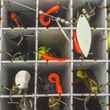
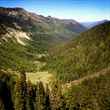
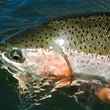









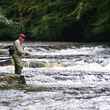









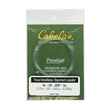




Comments
Glenn Dotter replied on Permalink
Good article. I agree with about 90-95% of what the author writes, and if you are new to this type of fishing you wont go wrong. His rod info is dead on. IM6 graphite is the best graphite. I like my 6.5' fiberglass for those small creeks. Those $1000 fast action rods are pretty much worthless on the small creeks.
I prefer furled thead leaders and nylon tippet. They just seem to turn over so nicely in short, tight locations. For flies, you dont need too many patterns. A couple of parachute dries and small nymphs will do fine. I have been a DT guy all my 62 years. I like WF on high lakes because I spend more time roll casting for distance.
The writer and I have our personal preferences, but if you follow his advice, you wont go wrong
Pages